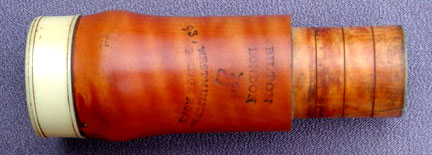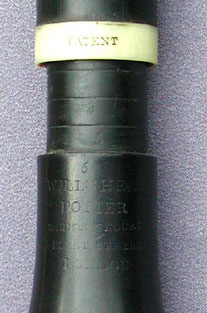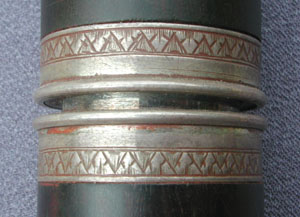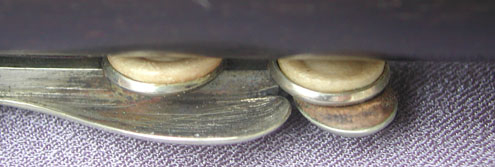Why keep a collection?
As a flute researcher based in Canberra, Australia, I'm a long
way from the major collections of flutes. The nearest is a
moderately sized but interesting collection at the Powerhouse Museum in
Sydney, the next after that in Los Angeles. So, if I wish to
conduct continuing research on instruments between trips, it's pretty
vital to have good examples at hand.
As a flute maker, I find the collection just as
important. Some of these instruments are models upon which I base
my own flutes (eg the Boosey & Co Prattens.) But the others
have their place too, providing ideas and inspiration for my
work. The link between today's makers and the 19th century makers
was broken by many years of indifference to the wooden flute. The
old makers left us little in terms of words and tools, and so their
instruments are their only point of contact. Spending time with
their instruments is as close as we can get to spending time with
them. Rarely would a day go by without me taking down one or more
of the flutes in my collection, playing it, playing with it and just
looking at it. The full appreciation for their work drives me on
in mine.
About the collection.
The collection is small, but representative of the various
generations of conical flutes from the 19th century. You will
notice that the instruments aren't in sparkling condition, indeed they
look rather like the ones you see in the major collections. And
for the same reason - I don't want to erase important details by
unnecessarily restoring them to apparently new condition. But it
is important for my analysis work that they do play, so I'm forced to
tread the fine line between restoring and repairing.
The "Acquisitions Policy"
Unlike a museum collection, this collection can afford to be
fluid. I am prepared to sell some instruments in areas where I
have a more useful example in order to build up the collection in areas
I do not have. So please feel free to contact me if something
here takes your fancy, or if you have something you think might take
mine. I'm also happy to consider deals involving original
instruments as part payment for my own new instruments. And I'm
not too concerned about the condition of instruments as long as they
have not been extensively modified.
The Collection
In presenting the collection below, I've arranged it under
headings to permit comparison between flutes from different countries,
and flutes of a similar generation
and different generations. I should make it clear that this
"generations" thing is a convenience of my own construction.
There may be better ways to look at the period, but I think this gives
us a handle on it we didn't have before.
I'll fill in a bit about the maker, the history of the
flute and point to any interesting features you should know
about.
Section One - English
Simple-System Flutes
One-key Flute by Clementi

Boxwood and Ivory with silver key, this is probably an early 19th
century instrument, before Clementi took on manufacture of Nicholson's
Improved models. Note the small holes, permitting the
cross-fingerings necessary for chromatic operation.
One key Flute by Blackman

On first viewing, you might mistake this flute for a cheap
modern replica, but indeed it dates from the mid 19th
century. None the less, one key, rosewood and nickel-silver
mark it as an inexpensive option at this late time. Despite the
lack of undercutting that would have been normal on earlier one-key
flutes, it speaks surprisingly well.
The Blackman workshop ran from 1810 to 1882 in various London
locations.
First Generation English 6-8 Key
Flutes
This first period of the eight-key flute brings us flutes which are
very reminiscent of the earlier one-key and four-key flutes with extra
keys added. We expect to see:
- small embouchures
- very small fingerholes, undercut
- boxwood and ebony
- ivory bands
- flat plate keys or pewter plugs
Boxwood 6-key by Bilton
Bilton set up his workshop in 1826, after working with Cramer, Florent
and Key. The address on this flute, 93 Westminster Bridge Rd,
suggests it's from between 1826 and 1856. His mark, a unicorn
head, is common to a number of makers, possibly implying they all
worked from a common address, at the sign of the unicorn.

The flute is in nicely-figured boxwood with sterling silver
square flap keys and ivory mounts. Note the small finger holes,
and the incised rings on the tuning slide cover and stopper
displacement indicator. The embouchure and finger holes are
generously undercut all round to offset their very small size.
The flute speaks quietly but with firmness.
 |
The barrel section of the Bilton, showing
the Unicorn mark and the incised rings on the slide which are intended
to match similar rings on the stopper indicator. |
 |
A closer view of the foot, showing the
nicely scalloped flat plate keys in use at the time. |
Ebony 8-key by William Henry Potter
William Henry Potter was born in London on 7 Aug 1760, son of
Richard Potter
(a.k.a. Potter senior), a leading flute maker of the
time. He apprenticed to his father in 1774 (age 14!) and joined
the company as
Potter & Son in 1800, taking over in 1806. He died unmarried
in 1848,
leaving the not inconsiderable sum of 30,000 pounds sterling.

This lovely flute was made in the period 1815 -33. It is
in ebony, with ivory
bands and sterling silver keys using his father's patented system of
pewter plugs sealing into fine silver tubes set into
the tone-holes. Finger holes are fairly uniform in size - the
ratio
of hole area between largest and smallest is about 2.
 |
The instrument is fitted with a tuning slide, the wooden
cover of which has three inscribed rings to mark the degree of
extension. The
fully closed position is marked "6", the first two rings marked "5" and
"4" and the third
one is unmarked),
The slide markings "4", "5" and "6"
hark back to the earlier days when different upper bodies (corps
de rechange) were supplied to handle the different pitches in
use. An
example of just such a flute by Richard Potter can be found in the Bate
Collection.
|
Second Generation English 8-key
Flutes - the "Improved" Era
Charles Nicholson the Elder ushered in the second generation
of 8-key flutes by daring to enlarge the finger holes on a typical
first-generation instrument by Astor. His son, Charles Nicholson
the Younger brought the flute to London. While everyone admired
young Nicholson's tone and power, convincing them that the flute was
the way of the future took some time and effort.
The piano and woodwind instrument company Clementi & Co
agreed to have flutes of Nicholson's style manufactured for sale
through them. The instruments were actually made by Thomas Prowse
who seems to have taken up their manufacture independently after
Clementi retired in 1831.
Once the "Improved" flutes were accepted, other makers were
quick to realise the benefits.
Hallmarks of a second generation
flute include:
- bigger holes to give better intonation and more power
- shorter lengths to achieve higher pitch
- cocus wood rather than box or ebony
- metal rings, usually silver
- saltspoon keys with "purse" pads, giving way later to
flatter cups with card-backed pads
- pewter plugs on the normally open keys, C4 and C#4
Clementi & Co C. Nicholson's Improved 8-key
Before we get too excited about the new age of big holes,
check out this apparent enigma. Proudly labelled as Nicholson's
Improved No 1403, but identical in lengths and layout with the Bilton
flute above, and with holes only a little larger.

So, were there degrees of improvement available, or was it
just good marketing? More work to be done here!
Note also the saltspoon keys on the two lowest foot keys,
where normally we would expect to see pewter plugs. Also the lip
plate, clearly added later as it partially obscures the maker's mark on
the head. The cap is no doubt a replacement - the original cap
should be covered by a ring matching those elsewhere on the body.
George Rudall, Willis Fecit, c 1820
When George Rudall returned to London from the Napoleonic wars
he took up as a flute teacher. That meant he needed a supply of
flutes for his students. He turned to established maker John
Willis for these. The flute below is marked Geo. Rudall, Willis
Fecit (Latin, literally: Willis made it.) Willis also supplied
similarly marked flutes to dealers such as Thomas Williams and Clementi
& Co.

The flute is in cocus, with silver rings and keys. The
head and barrel appear a little lighter in colour, probably due to the
finish being impaired by attention to cracks in these lined
sections. The head was probably originally unlined, as the
maker's mark appears just above but partly obliterated by the lower
ring.
This is another flute that could be argued to be a first
generation design. Supporting that view we have very small finger
holes, leather flap pads (albeit round and not square) and the vaulted
linkage to the low C key. Cocus, metal rings and a shorter scale
argue for the later category. "Transitional" would be a fair
reading, and would fit the dates well.
For more on this instrument ...
Prowse C. Nicholson's Improved 8-key
What better example of the new generation but a real Thomas
Prowse, C. Nicholson's Improved - No 3904. Visible in the picture
below are two of Nicholson's classic hallmarks - the head thinned
around the embouchure and the area around the right hand finger holes
flattened.

| An unusual feature of this flute is a long
F key whose touch bends upwards rather than downwards at the end. |
 |
For much more on this remarkable flute:
C. Nicholson's Improved - the
turning point.
J.B. Cramer, Addison & Beale, T. Lindsay's Improved.
Sounding more like a company of lawyers, J.B. Cramer, Addison & Beale
were probably just the marketing agents for the real hero of this piece,
Thomas Lindsay. He is listed as a flute and flageolet maker
between 1825 and 1833. Cramer et al were set up in 1824 and ran
under that name until 1844. Our flute presumably dates from within
those limits, and possibly between Lindsay's listed limits.

This is a superbly elegant flute, with holes smaller than the
Nicholson, but substantially larger than those of first generation
flutes. Note that it is a 7-key, as Nicholson himself preferred
and recommended, and that it carries the magic Nicholsonian word,
"Improved".
Lindsay published his views on flutes, including A Few Practical Hints
B&S Dulcet Improved.
Hmmm, there's the "Improved" word again. And it becomes
clearer that these various second generation makers are using it to
imply the same thing. Because they had abandoned the idea of
equal-sized holes, second generation flutes had substantially better
tuning over most of their range compared to the earlier instruments.
The B&S Dulcet improved is a very typical medium
sized hole flute. It was the 8-key flute I learned to play on
first and so I owe it a lot. I bought it from the late Paul
Davis, a scallywag dealer in flutes and concertinas who lived just off
the Portabella Road in London. The makers are believed to be the
company Samuel, Barnett.

Metzler 8-key
The Metzler family originated in Germany; Valentine Metzler
coming to London in 1788. V. Metzler gave way to Metzler &
Son in 1816 and then Metzler & Co when Valentine died in
1833. Under the command of the son, George, the company offered
"bassoons, serpents, clarionets, flutes, drums, horns, trumpets,
trombones and bugles". George retired in 1866, the company
continuing until bought out by Cramer in 1931.

The keys on Metzler's flute bear the imprint underneath of AL
- presumed to be the wind instrument maker Alexander Liddle.
Whether Liddle actually made the flute or just supplied the keys we
perhaps will never know. Liddle is listed from 1847 to 1879 which
is getting a little late for flutes of this generation.
 |
Metzler's flutes are not regarded as the
best of the period. Our example is however clearly one of the
better ones. The hand-graved sterling silver bands are not a
normal feature of Metzler flutes. Unfortunately, lack of the
customary address makes it impossible to date the instrument closely. |
On an historical note, the instrument was previously owned by
well-known London-based Irish flute player Roger Sherlock.
Rudail & Rose fake

I must admit that when I first heard of flutes being faked in the early
19th century, I was skeptical. But no more! The flute
above, provided by Adrian Duncan from Vancouver, is marked Rudail &
Rose, not Rudall. The workmanship is truly appalling. It's
a fake! For the full story on this Imposition
Upon the Public ...
Pakistani-made 8-key flute

In the late 20th century, several Pakistani firms began
manufacturing 8-key flutes, unfortunately without the benefit of
guidance or wisdom. The flute pictured above was sent to me by a
disgruntled owner, with a note asking me to do with it whatever I
thought best. It is a miserable instrument, poorly made,
out-of-tune, difficult to play. After some deliberation I concluded the
only appropriate use for it was to include it in this collection as a
warning to others.
Third Generation English 8-key
Flutes
Third generation flutes are more likely to show some of these
features:
- single piece body
- cocus still the dominant timber
- nickel or German silver sneaking in
- some post mounting
- shorter again than 2nd generation
- flatter keycups with card-backed pads
- pewter plugs retained for the two lowest notes
It's my feeling that Boehm probably ushered in the third
generation of 8-key flutes, but if so, it was unintentional.
Having been dismayed by the power that Nicholson could achieve on his
large-hole flute, Boehm was inspired to produce his 1832 conical
flute. It didn't catch on for a number of reasons, but it set a
lot of people thinking. One of these was Abel Siccama.
Siccama system 10-key, by Siccama
While Boehm's 1832 system flute was underpowered for English
taste and strayed too far from the old fingering, Siccama's subsequent
and patented Diatonic Flute satisfied both criteria but also delivered
better intonation than preceding instruments.
Our particular example is Siccama No 321. It bears the
screw-cup keys - a characteristic hallmark of Siccama's flute maker,
John Hudson.

See The Siccama Flute Story for
more on this flute and the two men who brought it to us.
Boosey & Co R.S. Pratten's Perfected 8-key
One of those who fell under the influence of Siccama's flute
was the rising young star performer, Robert Sidney Pratten. He
stuck with the Siccama for about 10 years, then went back to Siccama's
man Hudson and had him make a few changes and revert the Siccama flute
back to an 8-key. The result was marketed as RS Pratten's
Perfected.
Hudson left Siccama and went out on his own for a while, then
was snapped up by the new company of Boosey & Co, serving them as
foreman and continuing production of the Pratten's Perfected. Our
example is Boosey & Co RS Pratten's Perfected No 8626. I
picked it up in Sydney in about 1973 for AUD $25. Seemed like a
good idea at the time. Note that the metal used is Nickel Silver

The Pratten's Perfected is aptly named. All of the
previous serious problems with intonation have been dealt with in this
design. My Prattens Model and
Prattens Plans are based on this flute.
Rudall & Carte 8-key, No 7120
Now this flute is a bit of an enigma and perhaps should be
included under 2nd generation 8-keys. Yet, despite its decidedly
2nd generation look, it features 3rd generation performance. The
riddle is perhaps resolved when we discover its date of birth - 27
February 1893. This is some 46 years since Siccama and very
late for a flute of its appearance. Significantly, the length of
this flute is about the same as the RS Pratten's Perfected.

For much more on Rudall & Carte, and its
illustrious predecessors, see Rudall, Rose,
Carte & Co - the eight key flute years
Fourth Generation English 8-key Flutes
When Boehm's 1847 cylindrical flute finally
became established, diehards for the 8-key system attempted one last
stand - fit the familiar old keying system to the new cylindrical
bore. Needless to say, it didn't achieve any of Boehm's real aims
- improved venting and the like. But it sure kept the price
down!
Cylindrical bore 8-key by Moon
Moon of Plymouth was probably not a maker, but a
retailer who had instruments stamped for him. So we don't really
know who made the flute below. It mixes some typical 8-key
features with some typical Boehm features - the "parabolic" head, the
smaller embouchure, the cylindrical body, the short tuning slide
integral with the top tenon. Note at last we have lost the pewter
plugs on the bottom two notes.

The colour difference between body and head is
noticeable in real life but not to the extent our picture shows.
| The size of the bore can be better
appreciated in this comparison of the foot ends of the Moon and
Nicholson flutes. |
 |
Cylindrical Old-system flute by Rudall Carte

Similar in principle to the Moon 8-key cylindrical above, this flute
employs Siccama's approach of extending the third finger of each hand
with a key. This substantially reduces discomfort while improving
tuning and response. The Boehm foot is a considerable improvement
over the old grasshopper's knees foot, and there are trill keys
giving the notes D" and E".
Cylindrical English Old-System Flute

This anonymous old-system flute originally employed keys over every
hole, but as you can see several haven't made it this far.
Although looking complex, there is no interaction between the
keys, so the operation is simply 8-key.
Section 2 - French Simple System
Flutes
By the start of the 19th
century, the French seem to have settled on the 5 key flute with short
D foot as their standard. But anywhere development seems
unavoidable.
French 8-key

This flute purports to be Australian made, bearing the mark
"Nightingale / A.P. Sykes / Melbourne". It is clearly a typical
French 8-key (the long F is missing) and was no doubt made in France
and re-badged for sale in Australia. Note that the hole sizes are
similar to the German flutes' and the English flutes before
Nicholson. Special thanks to Colin Goldie (Overton Whistles) for
getting this repatriated to Australia.
Tulou's System Perfectionee

A Tulou System Perfectionee, made by Buffet Crampon. Essentially
a French 8-key plus trill keys for D and E, a duplicate C key operated
by L3, and the characteristic F# sharpening lever operated by R3.
This flute employing stand-alone keys, some Flutes Perfectionee
employ rod & axle construction, and some a mix of both. This
flute was a French Conservatoire reaction to Boehm's instruments - a
last ditch attempt to retain small holes and soft dark sound.
Section 3 - German Simple-system
Flutes
Given Germany's auspicious
history in the development of the flute, the 19th century was less than
inspiring, with the obvious exception of Herr Boehm. Cheap,
usually anonymous German flutes flooded the world market, particularly
in the US. The Sears Roebuck catalog carried them for about $5
for an 8-key, around 1900.

Simple 19th century German 1-key flute

A typical German 4 key flute.

German 8-key flute, ivory head, cocobolo body (the barrel is a
temporary replacement).

German 12 key flute. In addition to the more typical 8 keys,
there is a trill for E, a second G# operated by the left thumb, a
second Bb touch for R1 and a low B operated by L4. Note also the
line-up dots at each junction.

A Schwedlerflöte, the jumping-off point for the German Reform Flute
movement. Very similar to the 12-key flute above, apart from the
Brille mechanism to sharpen c#, Boehm-style foot keys, the metal head and
ebonite "reform embouchure".
Section 4 - American Simple System
Flutes
Pond 6 key

A flute by Wm. A. Pond, 47 Broadway, New York. Marked "German
Silver". Essentially similar to the Firth & Pond which was the
subject of my Interesting Collaboration with Grey
Larsen, and lead to the introduction of my Grey
Larsen Preferred range of flutes.
Section 5 - Boehm System
Flutes
Theobold Boehm was by any account a remarkable
man - Schafhautl's concise biography translated and reprinted in
Christopher Welch "History of the Boehm Flute" leaves no other
interpretation open. Boehm made two major forays into the flute
world - his conical instrument of 1832 and his cylindrical instrument
of 1847. Both created Tsunamis.
Conical 1832 Conical Boehm by Laube.
This French made flute would date from the end of the 19th
century. While Boehm's 1832 conical design didn't catch on in
England, it was received much more warmly by the French. Believed
to be acoustically very similar if not identical to the 1832 flute, the
system of keying is much more similar to that used on the modern Boehm.

| An interesting feature of Boehm's 1832 instrument
perpetuated in the Laube is the use of two small tone-holes at the
thumb c key, needed to stabilise third octave G. |
 |
Armstrong Model 90
What flute collection would be complete without a
"plain vanilla" cylindrical Boehm flute? This one comes from my
short career
as a metal flute player.

Even this flute has an interesting tale to
tell. It was built in the early 1970s in the U.S.
where pitch had
been standardised in about 1921 to A 440Hz. None the less, the
instrument is in better tune pulled out to A 435, Boehm's pitch.
Section 6- Flutes after Boehm
Not everyone liked Boehm's cylindrical flute. Some rejected it
out of hand, others sought to use the new cylindrical bore but retain
the old fingering, at least as much as possible. One of these was
Richard Carte, who quickly came out with his 1851 Patent flute.
He revised the design in 1867. The flute below is an
example of this.

Rudall
Carte & Co, No 2443, an 1867 Patent flute in ebonite, at high pitch.
|